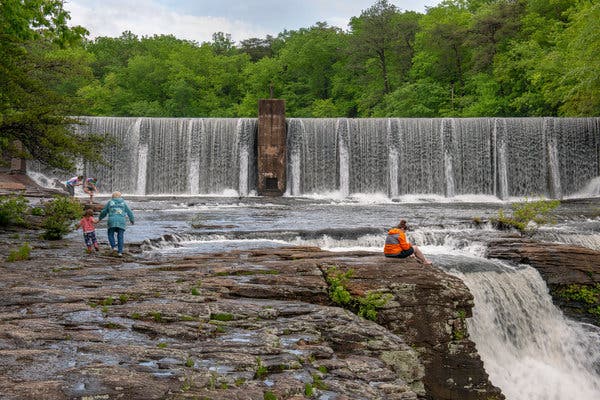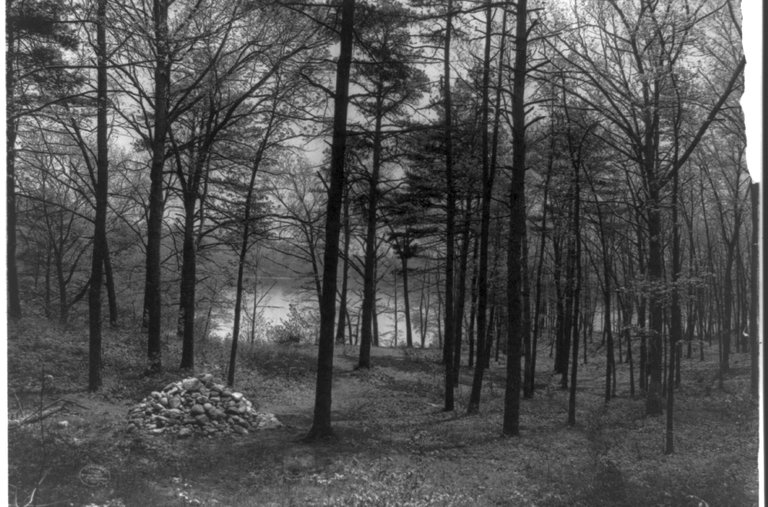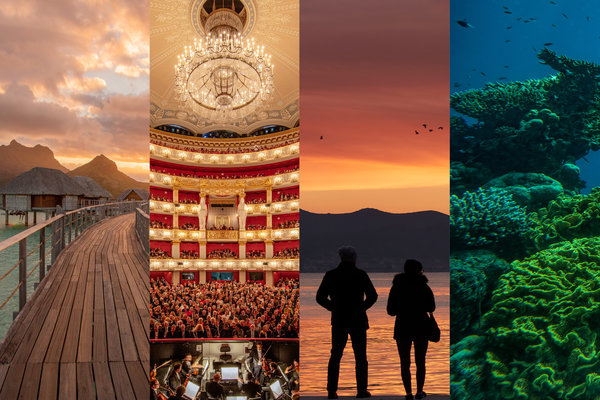An island of glacier-tumbled rock, covered in trees, sits in the cold waters of Lake Michigan. On the horizon, it looks like the gathering of night. This is Wisconsin’s Rock Island State Park, where my love of nature began.
Thirty years ago I spent part of a summer there with a troop of the Polish Boy Scouts, which is a story in its own right. We slept on rusty cots, played dubious games with pocketknives, tramped around the island and jumped into its hidden coves. Our clothes started to grow fungus and we may have blown up cans of creamed corn in bonfires. It was glorious.
Rock Island is one of 8,565 state parks that are scattered across all 50 states. Some, like Niagara Falls, have international stature, but most are like Rock Island, locally popular but otherwise unknown. Some are no larger than city parks; others are as grand as national parks. Last year I visited 53 of them, from Mackworth Island State Park in Maine to Wailuku River State Park in Hawaii.
As I began my yearlong exploration, a question nagged at me. Are state parks just less impressive versions of national parks? Eventually I realized the question made no sense. The two each have unique traits that make comparisons impossible. The singularity of state parks is their meld of nature, history, local culture and ordinary life. Here you find rites of passage, first campfires, an escape from work, and a quick, cheap break. National parks belong to everyone. State parks belong where they are.
Still, the two are connected. State and national parks share the same origin story and the same mission of introducing people to the outside. Imagine national parks as high-profile museums of nature — the Louvre of wilderness or the Metropolitan Museum of trees. State parks are regional museums, the kind of place where you find surprising treasures and the occasional masterpiece.
For example, they often bear the marks of thousands of years of human activity, presenting a conception of America very different than the one I grew up with. In school, I was taught that ours was a young country, bursting into nearly untouched land, taking over huge swaths of empty territory with ambition and derring-do. However, state parks taught me that the land that is now the United States is ancient. If you look, you’ll find the traces of many cultures now lost forever.

Visitors enjoy the water below A. A. Miller Dam in DeSoto State Park, which was built in the 1930s. CreditRobert Rausch for The New York Times
Steeped in culture and history
Stephen Mather, the first director of the National Park Service, also helped establish state parks. Concerned that the average citizen would not have easy access to national parks like Yosemite, Mather proposed a national movement of “comfortable camps all over the country, so that the motorist could camp each night in a good, scenic spot, preferably a state park.” In 1921, he organized the first National Conference on State Parks, whose rallying cry was “a state park every hundred miles.” It is remarkable the extent to which this vision has come to pass, as I soon discovered.
My first trip took place a year ago in March, through the Midwest. (This is the first of two articles on state parks around the country.) Nestled in our minivan, our family drove under a gray, overcast sky, past endless fields the color of burned wheat. By the time we arrived at Hocking Hills State Park in southeastern Ohio, I wasn’t expecting much.
About an hour from Columbus, Hocking Hills turned out to be so ethereal and mystical it could have been the inspiration for the elvish home of Rivendell. Our destination was Ash Cave, a massive overhang cavern interlaced with waterfalls and streams. As we walked along, water droplets hovered in the air and misted the primeval forest. Because of Hocking Hills’s unique topography of cliffs, gorges and rivers, its climate is a vestige of an era when glaciers had just begun to recede, and trees such as the Eastern hemlock, the Canada yew and the mountain laurel dominated. I couldn’t believe it: Visit a state park and stumble into ancient Ohio.
As was the case in so many state parks, the culture and history of the area was woven into its fabric. It seemed like every other person wore an Ohio State University sweatshirt. Digging beneath Hocking Hills’ caverns, archaeologists have unearthed thousands of years of campfires. We climbed a path that swung deep into the bowels of Ash Cave, read old graffiti and followed rows of damp ferns behind waterfalls. Hocking Hills averages more than two million visitors a year, and is so popular it is expanding its facilities to accommodate more people.
We visited other state parks during our Midwest road trip, but none left as strong an impression as Prophetstown State Park in northern Indiana. For years I’ve driven past on the interstate and wondered how it got its name. The reason was more macabre than I expected. In the early 1800s, Native Americans were being pushed from Ohio. The Shawnee brothers Tecumseh and Tenskwatawa decided to organize a confederacy of Indian nations to fight back. Their capital was a settlement called Prophetstown. In 1811, Gov. William Henry Harrison led an army against this confederacy, and they met at the Battle of Tippecanoe. Harrison’s forces won. Afterward he led his men to Prophetstown and burned it to the ground.
None of this history is hidden. There are even a few structures to look at, identified on the map as “Native American Village.” It is Indiana’s newest state park, with 110 camping spots, trails showcasing prairie and forest as well as an aquatic center with water slides. To me it was a strange decision to build a state park near the place of such pain. Then to call that state park Prophetstown seemed like yet another insult, the taking of the settlement’s name for the victor’s future amusement.
But as we headed home, I wondered if I was being unfair. The state park did us a service by explaining the area’s past. Still, I couldn’t dispel the image of vacationers playing on the burned-out ruins of someone’s home.
Origin stories
America’s complex history stayed with me as the school year ended and our family embarked upon a summer road trip across the South and the Eastern Seaboard. Mindful of Prophetstown’s story, I delved into the history of each state park we visited. Sometimes they were created after years of broad debate. Others were muscled into being by one or two people. Sometimes they felt like sweet afterthoughts. One of our first stops, DeSoto State Park, tucked into a corner of Alabama, was one of these.
It had been raining for days when we arrived; water dripped and flowed all around us. Rampant vines and flowering bushes give the area a fantastical aura, as if this old state park had become a floodplain of the Amazon River. Everything seemed larger than normal — tree leaves were the size of dinner plates and caterpillars looked like they had swollen to several times their normal size. The buildings were old and slick with moss. There was a nature center too, with stuffed animals on tables and hanging from walls. Randomly, there were living creatures as well: a fish tank and a very confused squirrel pacing back and forth in a forest scene diorama. It, and the park, seemed lost in time.
DeSoto’s buildings were erected in the 1930s by the Depression-era Civilian Conservation Corps, back when it was named Alabama’s “State Park #5.” Like other state parks I visited, it was not expensive. Entrance was free and tent camping was $15 a night. When we visited in the middle of the week, the park wasn’t empty, but it wasn’t filled with people either. I counted just a handful of cars that day.
Sometimes, think off-season
Two weeks later and a thousand miles away, we plunged into the opposite extreme, the frenzy of summer in New England state parks. We were camping at Burlingame State Park in Rhode Island, a modest woodland area about an hour from Providence. It offers more than 700 campsites, a camp store, a playground, shower facilities — the works. The woman checking us in said it was a busy weekend; every campsite was reserved.
By the time we had finished roasting hot dogs over a fire and had moved onto s’mores, the meadow was filled with lanterns, laughter and the murmur of collective conversation. The one thing I didn’t see was the glow of a phone or tablet. That Friday night in July, no one appeared to be online.
Burlingame is Rhode Island’s first campground, built in the 1930s as part of a broader effort to bring “recreational relief” to nearby urban dwellers. At Burlingame, this relief takes the form of strolling through forests, jumping in ponds and joining a makeshift tent community that springs up in the waning hours of a sweaty summer workweek.

As crowded as Burlingame was, however, it didn’t hold a candle to the full-on outdoor recreating going on at Walden Pond on the outskirts of Boston. I visited early on a Sunday morning, thinking it would be the perfect time to “experience the connection with nature that inspired Henry David Thoreau’s Walden,” in the words of the park’s website. Not so much.
My first clue was an impressively long line of cars waiting to enter the parking lot. I thought it might be a race or a festival of Thoreau lovers, but no, it was just an ordinary summer Sunday. The attendant at the gate said I was lucky to get a spot. He added that the Sunday before, all the parking lots (A through F) were filled by 7:20 a.m.
After parking, I walked around and quickly realized all these people were not environmentalists paying homage to Thoreau. Walden Pond itself, the object of Thoreau’s patient contemplation, was filled with lane lines and buoys. One area of the pond was devoted to geared-up swimmers checking their lap times on watches. Another area was divided into grids for beginning swimmers and children. People shouted at each other across the pond. On the beach, a group was holding a prayer service and blasting a shofar.
Since I was there, I figured I might as well walk to the site of Thoreau’s cabin. The trail is hemmed in by a tall wire fence that prevents anyone from actually entering the forest and experiencing nature. Intense trail runners pushed past, and I grabbed onto the fence to avoid being shoved into it. Finally at Thoreau’s cabin site, I took pictures of the ground where the cabin had been and then left for the well-stocked gift store.
In his chapter on solitude, Thoreau contemplates the emptiness of Walden Pond. “What company has that lonely lake, I pray?” The parking attendant told me 37,000 cars visited Walden Pond in July 2017.

Clearly, summer is not the time to commune with Thoreau’s spirit at Walden Pond. I was surprised, but not disappointed. The popularity of state parks like Walden Pond demonstrates their continued vitality. I’m rooting for them to be busy. Despite all the differences in our daily lives now compared to the 1930s, when the number of state parks took off thanks to the Civilian Conservation Corps, visiting these places in the summer made me realize people still want to enjoy the outside. The pleasures of watching children run along dirt roads and sitting around a campfire are timeless and relaxing in a way that can’t be taught.
Losing track of time
Given the thousands of state parks out there, I used a mostly random method to decide which to visit. If state parks were near friends, family or work travel, I stopped by. Only a few did I intentionally visit, and Niagara Falls State Park was one of those. Not only is it the oldest state park continuously operated in the United States, it is considered an inspiration for the national and state park system. Back in the 1800s, the falls had become a mob scene of hucksters and industrial activity. A “Free Niagara” movement pleaded for the return of the falls to their natural state and a guarantee of public access. The movement was successful and in 1885, the New York State legislature passed a law protecting the United States’s side.
My family and I arrived at Niagara Falls early in the morning and joined the nonstop parade of tourists. We entered the Cave of the Winds and stood in line to receive complimentary foam sandals. We tramped around the base of the falls and got very wet. Later, we watched Maid of the Mist tour boats push against the current, and gazed at a double rainbow that spanned the river. We spent about three hours there, and by the time we left, the crowds had gathered in force.
It was around Niagara Falls, near the end of our road trip, that we disengaged from the precision of time. Our daily routines had become simple: Stop at a state park, jump in the water, visit with friends if any were nearby, and repeat. Every place we went, we happily joined state park staycations — local people taking an afternoon off, or camping for a day or two.
As we drove west, heading home to Chicago, images from the trip drifted through my head: a caterpillar shuffling like a bear along a wooden rail in the Deep South, a perfectly round stone skipped into Lake Erie. Then my mind settled on one moment that seemed to encapsulate the role of state parks in our lives. It took place at Gilbert Lake State Park in upstate New York, early afternoon under a cloudless sky, the deepest part of summer. Sunlight shone on every surface — sand, water, skin, trees, hair — claiming luminous dominion over the world.
I sat in a forest glade just above the swimming area, breathing in the thick and languid air. Peals of laughter rose from the lake, mixed with yells of “Marco … Polo!” The smell was of pine needles and sunscreen and a far-off grill. Everything belonged right where it was.
A wooden platform floated offshore. It rocked back and forth, filled with slippery children screeching and diving into the water. An older man, white-haired and potbellied, wearing American flag trunks, stood in the middle. Like a statue he watched the hubbub around him. Suddenly he broke into movement, dashed to the edge of the platform and sliced gracefully into the bright blue water. Without a ripple.
Follow NY Times Travel on Twitter, Instagram and Facebook. Get weekly updates from our Travel Dispatch newsletter, with tips on traveling smarter, destination coverage and photos from all over the world.






